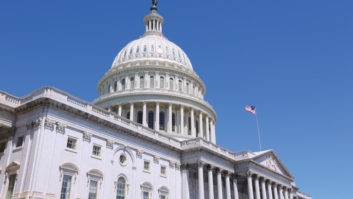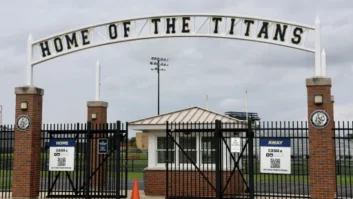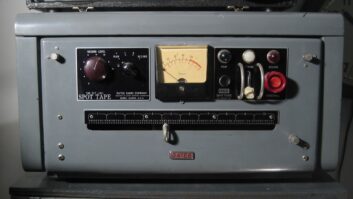OTTAWA, Ontario — Throughout the history of radio broadcasting right down to today, there has been a single great divide that separates all radio stations.

At 330 meters (1082 feet) tall, Arvia’s Emley Moor tower is the tallest freestanding structure in the United Kingdom.
Credit: Arqiva On one side of this divide are those stations that own and operate their transmitter sites. This ownership allows these broadcasters to control the signal path from the studio right to the listeners’ receivers. Emmis Communications, which owns 19 FM and four AM (MW) in the United States, is an example of this first group.
On the other side are stations that feed their studio signals to third-party “transmission providers.” In doing so, these broadcasters relinquish distribution control for a regular fee paid to the transmission provider, who has to handle the operational and upgrade costs of the transmitters and masts used by their client stations. The British Broadcasting Corp., whose radio and TV programs are broadcast by third-party transmission provider Arqiva, fits into this second category.
HISTORY DRIVES THE DIVIDE
In most cases, a broadcaster’s choice of either in-house or third-party transmission facilities is rooted in their company’s history, and the history of the country they reside in. For instance, some European governments require broadcasting and transmission facilities to be separately owned by law.

The Arqiva Crystal Palace transmitter site is located at Bromley, London.
Credit: Wiki Commons In the United States, radio’s growth was driven by the private sector, with individual companies setting up their own stations and transmission plants on a local basis. This pattern, which was established back in the 1920s and 1930s, still dominates today.
“In general U.S. radio stations control their own transmitters and towers,” said Sam Caputa, director of radio engineering at Emmis Communications. “Although there are now many instances where stations in a single city share transmission facilities on a common broadcast antenna — because it is easier to convince local government to allow one shared mast versus multiple individual towers — the privately-owned model is very much how we do business here.”
In the U.K. and Europe, radio broadcasting began under the guidance of the state. This meant that public-owned broadcasters such as the BBC and their national counterparts were the first to the scene in the first half of the 20th century, with private radio only being allowed many decades later. (In Germany, private broadcasters only won the right to set up their own transmitter sites in 2015, while all antennas remain under the control of the transmission services provider, Media Broadcast.)
This model explains why the BBC uses Arqiva to transmit BBC radio and TV nationally. Originally, the BBC owned the transmitters and towers it broadcasts from, but these were sold to a private company in 1997. Eventually these assets and others in the U.K. came under the control of Arqiva.
Today “we operate around 1,450 radio transmission sites in the U.K.,” said Richard Johnston, Arqiva’s head of commercial radio. “We are a shareholder and operator for both commercial national DAB radio multiplexes and service provider for the BBC national DAB radio multiplex. We also work with independent radio groups, such as Bauer Media and Global Radio.”
IN-HOUSE MODEL

Arising through the London fog, the Arqiva Crystal Palace tower broadcasts FM, DAB and HDTV signals across London.
Credit: Wiki Commons For a radio station, the advantages and disadvantages of owning their transmitter and antenna tower(s) are akin to owning an apartment versus renting it. Ownership gives the station control, but they also end up paying all of the bills for the transmission chain. This includes coming up with substantial cash should a storm fell their tower, as opposed to having their “landlord” pay for a new tower while the rent stays constant; or, at best, goes up a bit.
Emmis’ Caputa can understand the positive side of having someone else handle the transmission and antenna needs. “I can see the advantages of using a common provider where the costs are shared between multiple users, and we don’t have to worry about the day-to-day details of running the transmission equipment,” he said. “However, giving up control to a third-party is not something that our company is particularly comfortable with, nor are many other U.S. radio broadcasters.”
This discomfort is again historical: Back in the days before studio to transmitter link (STL) wireless connections between radio stations and their transmission sites, U.S. broadcasters had to rely on third-party telephone lines to make these connections. Even when relations were good between these broadcasters and the country’s telephone company — and they often weren’t — the firms didn’t always give radio stations the quality level and cost of STL landline service they wanted.
“With STL links, we can control our own destiny,” said Caputa. “The same is true for owning and operating our transmitters and antennas.”
This preference makes sense to Ruxandra Obreja. As chairperson of the Digital Radio Mondiale consortium, she consults with radio stations and networks interested in this form of digital radio broadcasting. In the process, she hears their concerns about owning versus leasing transmissions facilities.
“If a broadcaster wants to maintain a very specific and desired coverage, therefore ensuring localism and targeted advertising, being in control means that you do not pay the overheads of handing this control to a third party, which will be the deal maker, breaker and negotiator,” Obreja said.
Meanwhile, “Any change to a multiplex setup needs to be negotiated among the participants and will come at a cost. Unless the multiplex is used to capacity or the provider has a very wide portfolio a multiplex can be the more expensive option. This sort of ‘commune’ model is never so smooth when advertising money and audience share is at stake.”
THIRD-PARTY MODEL

The BBC World Service transmitter site at Nakhon Sawan, Thailand, is operated by Babcock International.
Credit: BBC World Service Nigel Fry is head of distribution for the BBC World Service Group, which uses transmission services provided by Babcock International Group. “At BBC World Service we have first-hand experience of an outsourced transmission operation and with other arrangements,” Fry said.
“There are many factors that mitigate in favor or against such arrangements: In our case the relationship with our service provider has enabled us to respond to changing business needs by making considerable changes to our requirements and in turn and achieving significant savings.”
The big saving not just for the BBC World Group, but BBC proper and any other broadcaster using third-party transmission services, comes from their providers having to pay operational, maintenance, and capital cost for the broadcasters’ transmitters/antenna sites. Although these costs can (and do) get passed through to the stations/networks in the form of fee increases, these increases are far easier to absorb than the cost of directly paying to buy new transmitters or replace towers knocked down in a storm.
“Remember that in the U.K. many stations have more than one transmitter; some have more than 200, some have four or five covering different areas,” said “radio futurologist” James Cridland. “Additionally, most simulcast on DAB, which also requires a set of transmitters too. Economies of scale quickly mount up when you have many different outlets.” Add the fact that U.K. radio licenses are only issued for seven-year periods, and “it isn’t particularly economically practical to run your own transmission: certainly for the higher-powered services,” he said.

Ruxandra Obreja is chair of Digital Radio Mondiale.
Credit: Digital Radio Mondiale DRM”s Obreja countered that when it comes to adopting DRM digital radio, for some stations “it might be much cheaper to buy a digital transmitter, reduce the energy cost to up to 80 percent and recoup the initial payment,” rather than to join and co-fund a DAB multiplex with other digital radio broadcasters.
For U.K. broadcasters, being able to rely on Arqiva simply makes their lives easier. “We pick up the audio directly at their studios,” said Johnston. “We then take care of the rest to ensure that content arrives safely at hilltop transmission sites, uplink sites or at muxing centers for digital radio.”
“Having an independent body of some scale operating the transmission infrastructure in the U.K. provides broadcasters with a number of benefits,” he added. “We are able to employ experts in all areas of transmission technology and make those experts available to all our radio customers. These shared skillsets contribute to our ability to provide 99.9 percent availability of services to our customers.”
Meanwhile, “having a single provider allows for easier coordination of government and industry strategy,” Johnston continued. “For example, when the U.K. rolled out digital radio [DAB] services the government only needed to coordinate with Arqiva to deliver the transmitter capabilities required. Arqiva is independent of the broadcasters so has no commercial interest in one over the another.”
CIRCUMSTANCES
As with the decision of owning versus renting an apartment, there is no “one-size-fits-all” answer to the choice between in-house and third-party transmission/antenna services. But there are definite pros and cons to each approach, with the basic decision coming down to whether a broadcaster considers facility control to be more important than cost control — or vice versa.
James Careless reports on the industry for Radio World from Ottawa, Ontario.







